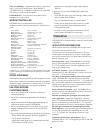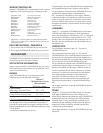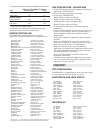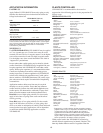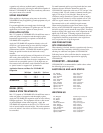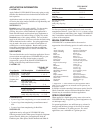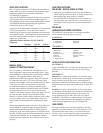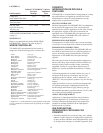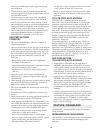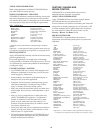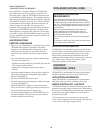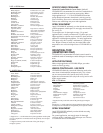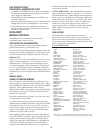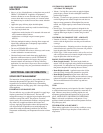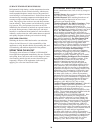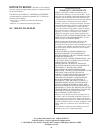
USE PRECAUTIONS
INDUSTRIAL UNIMPROVED TURF
• Use DuPont™ VELPAR® DF only in stands of bermudagrass
and bahiagrass established for at least one year. Do not treat
newly sprigged or sodded areas.
•
Some discoloration of the bermudagrass or bahiagrass may
o
ccur after application.
• Injury may result when desirable grasses are under stress from
drought, insects, disease, cold temperature, or poor fertility.
• Severe turf injury may occur if applications are made on
gravelly or rocky soils, thinly covered subsoils, or soils with
less than 1% organic matter.
NON-CROP
BRUSH CONTROL
VELPAR® DF is recommended for the control of
undesirable brush in non-crop sites.
APPLICATION INFORMATION
Apply VELPAR® DF from late winter through summer,
prebud break until new growth hardens off.
In areas where the soil remains frozen during the winter and
spring rains are usually inadequate for soil activation, a fall
or winter treatment may be applied before the soil freezes.
BROADCAST
Apply 5 1/3 to 10 2/3 lb of VELPAR® DF per acre as a coarse
spray by ground equipment or 5 1/3 to 8 lb per acre by air
(helicopter only). Use enough water for thorough coverage.
For ground equipment, usually a minimum of 25 gallons per
acre. For aerial equipment, usually a minimum of 10 gallons
per acre. Higher volumes of water may be needed when water
temperatures are cold or the higher rates of VELPAR® DF are
used.
BASAL (SOIL)
SINGLE STEM TREATMENT
Mix 2 2/3 pounds of
VELPAR® DF with sufficient water to
make one gallon of suspension and thoroughly agitate. Apply
the VELPAR® DF suspension with an exact-delivery handgun
applicator. This equipment delivers a thin stream of
predetermined volume when triggered. Apply the VELPAR®
DF suspension at the rate of 2 to 4 ml for each inch of stem
diameter at breast height.
Direct the treatment to the soil within 3 feet of the root collar
of woody plants to be controlled.
For multi-stemmed and low-growing brush that have stem
diameters that are difficult to determine, apply the VELPAR®
DF suspension at the rate of 2 to 4 ml per 3 feet of canopy
width. F
or tall,
slender (columnar) br
ush types,
a
pply 4 to 8
ml per 3 feet of height. Base the rate on whichever canopy
dimension is g
r
ea
ter (width or height).
When treating brush that requires more than a single delivery
of the VELPAR® DF suspension, apply subsequent deliveries
equally spaced around the target plant. If treating brush on
sloping sites, apply most of the suspension on the uphill side
of the stem. If treating resprouts from brush disturbed by
cutting or other mechanical methods, the rate of application
should be proportional to the original tree size, not just the
size of sprout regrowth.
LACING/STREAKING - Mix VELPAR® DF with water to
f
orm a concentrated suspension. Apply 5 1/3 to 10 2/3 lbs of
VELPAR® DF per acre. Adjust the application equipment to
deliver a narrow or straight stream spray pattern such that the
swath width on the soil surface is 6 to 12 inches wide. Direct
t
he spray at the base of the brush. Swaths or treated bands
should be 2 to 4 feet apart. Apply the lower volumes for
coarse textured soils or soils with low organic matter and the
higher volumes for fine textured soils or soils with high
organic matter.
USE RATES
VELPAR® DF is recommended for the control or
suppression of the following species in non-crop sites. Use
lower rate on coarse-textured soils (sand to sandy loam).
Use the higher rate on fine-textured soils(clay loam to clay)
and on soils high in organic matter.
5 1/3 to 10 2/3 Lb/Acre
*
Suppr
ession – a visible reduction in plant population and/or plant vigor
as compared to an untreated area and generally not accepted as control.
Alder Alnus spp
Ash Fraxinus spp
Aspen Populus spp
Bir
ch
Betula spp
Blackgum Nyssa sylvatica
Bay, sweet Magnolia virginiana
Catclaw acacia Acacia greggii
Cedar, Eastern red Juniperus virginiana
Cherry, black Prunus serotina
Chinaberry* Melia azedarach
Deerbrush Ceanothus integerrimus
Dogwood, flowering* Cornus florida
Elm, American Ulmus Americana
Elm, Chinese Ulmus parvifolia
Hackberry, common Celtis occidentalis
Hawthorn Crataegus spp
Hazel Corylus spp
Hickory Carya spp
Huisache Acacia farnesiana
Juniper Juniperus spp
Locust Robinia spp
Lotebush Ziziphus obtusifolia
Manzanita, Greenleaf Arctostaphylos patula
Maple, red Acer rubrum
Mesquite Prosopis glandulosa
Mulberr
y
Morus spp
Oaks Quercus spp
Osage-orange Maclura pomifera
Persimmon Diospyros spp
Plum, wild Prunus munsoniana
Poplar, balsam Populus balsamifera
P
oplar, yellow
Lir
iodendron tulipifera
Pr
i
v
et
Ligustr
um spp
Rose, multiflora Rosa multiflora
Sassafras* Sassafras albidum
Soapweed, small (yucca) Yucca glauca
Snowbrush (varnishleaf) Ceanothus velutinus
Sourwood Oxydendrum arboretum
Sumac Rhus spp
Sweetgum Liquidambar spp
T
allow, Chinese
Sa
pium sebiferum
W
axm
yrtle
Myr
ica cer
ifera
Whitebrush Aloysia gratissima
W
illow
Salix spp
22



